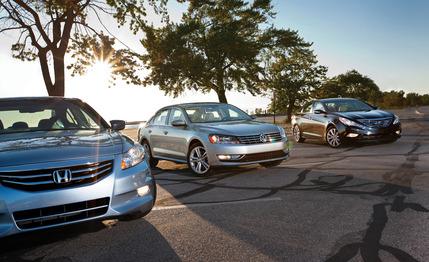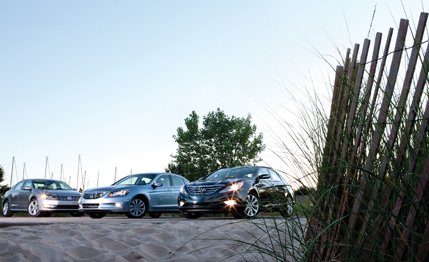 Comparison Tests
Comparison Tests

Volkswagen has big plans for the United States. Big, as in 800,000-sales-by-2018 big, which is more than three times what it sold here in 2010. First came the Jetta, price-cut for the American market, universally unloved in the C/D office, and selling like hotcakes to the car-buying public. The new Passat takes the Jetta approach a step further, not just reconstituted for our bland, ketchup-loving palates but specifically built for and in America.
VW set pricing low, at a suggested $20,765 to start, $7180 less than the 2010 Passat. But we’re hardly interested in the Walmart model, with its anemic 2.5-liter inline-five making a meager 170 horsepower. And the Passat TDI, as the only affordable mid-size diesel on the market, is quite literally in a class of one. That leaves the Passat 3.6, fitted with a 280-hp, single-head narrow-vee six-cylinder and a six-speed dual-clutch transmission.
The powertrain is pure VW, the perfect foil for determining whether the rest of the car is true to the brand that brought us the GTI. A Passat 3.6 in SE trim starts at $29,765. Our particular car, a $33,720 as-tested SEL model, includes amenities such as keyless ignition, remote start, leather seats, a 6.5-inch navigation screen, power passenger seat, wood inlays, and extra chrome interior trim.

Whether the Passat is a worthy VW may be something only a die-hard few care about; how it compares with the competition is much more significant. So we invited comparable versions of the two family sedans on the Car and Driver 10Best list: the Honda Accord and the Hyundai Sonata. In EX-L V-6 form with a $2200 navigation option, the $32,600 Accord checks every factory-equipped option box.
The Sonata, introduced last year as a 2011 model, is similarly loaded in 2.0T Limited guise, albeit with the lowest price in the group, at $31,285. Running changes for 2012 Sonatas include a panoramic sunroof; a bigger, seven-inch touch screen; and a 1-mpg bump in EPA highway fuel economy to a best-in-test 34.
If the Passat can hold its own against two of the best in the family-car segment, it stands to reason that Volkswagen’s ambitions could be realistic. There’s only one way to find out.